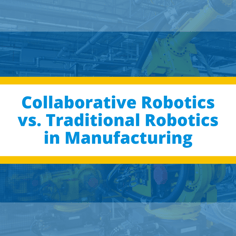 There is no one-size-fits-all solution in the world of manufacturing. Automating processes is a complex issue, with robots ranging from the size of an insect to as powerful enough to move automobile chassis. In recent years, a new term has been coined by manufacturers and machine builders to define a breed of robots that can work in conjunction with human presence: collaborative robots, or cobots.
There is no one-size-fits-all solution in the world of manufacturing. Automating processes is a complex issue, with robots ranging from the size of an insect to as powerful enough to move automobile chassis. In recent years, a new term has been coined by manufacturers and machine builders to define a breed of robots that can work in conjunction with human presence: collaborative robots, or cobots.
Traditional robots are known for their effectiveness when it comes to carrying out repetitive tasks, but they’re also known for their ability to induce damage if someone gets in their way. Cobots on the other hand are robots that are perfect for small to mid-sized companies looking for a helping hand in light tasks. This allows them to finally gain an upper hand in the market, providing them the benefits of automation that were previously only available to large-scale manufacturers.
While this new breed of robots can’t provide all the benefits associated with their counterparts, they definitely bring a number of new possibilities to the table.
Cobots
These robots are designed to work within pre-defined workspace with human operators, assisting them with their tasks. Just like typical robots, cobots also carry out tasks that are cumbersome and repetitive in nature, which would otherwise expose humans to injury. For instance, a cobot can go along with machine tending or palletizing while the human worker performs a more creatively demanding task.
Pros
- Can share workspace with humans
- If safety cells aren’t required, the cost of integration can be brought down
- Simple in terms of programming and integration
- Return on Investment (RoI) usually comes through in a year
Cons
- Thorough risk assessment is required if multiple human operators are involved
- Safety precautions may result in low operating speeds that can bring down productivity in certain cases
- The robots won’t be able to function after a specific point without operators
Industrial Robots
Industrial robots are automatically controlled, programmed and used for multiple purposes, usually for operations involving three or more axes. Multiple robots can be integrated for a fully automated workspace where human operators can’t interfere. While these robots are highly robust and resourceful, they can include a slightly larger price tag, and require automated safety checks to ensure their workability.
Pros
- Much more accurate and faster than cobots
- Fully automated workspaces can handle applications at speeds that can’t be attained by humans
- Even though the price tag is hefty, the RoI is achieved in a year due to the high rate of operation
- Have been in use for decades so extensive support available in terms of programming and development
Cons
- Unsuitable for low volume processes
- Can’t be turned into self-learning robots and usually rely on programmed modules
- Design changes can result in added costs
- May require specialized personnel for maintenance tasks
- Extensive work has to be carried out for creation of safety cell if human intervention is required
Premier Automation designs and implements automatic robotics systems for industrial OEM and End User customers.
Interested in learning more? Speak to one of our experts!




